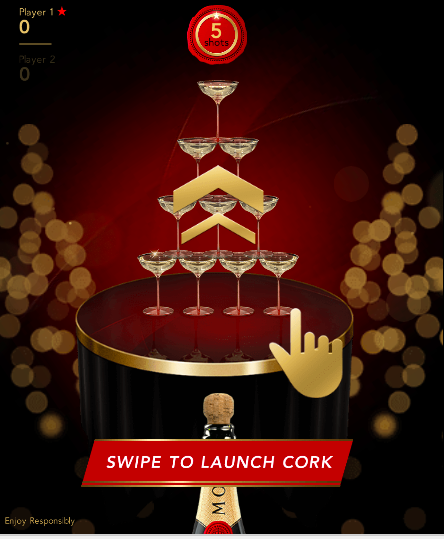Save 50% on a 3-month Digiday+ membership. Ends Dec 5.
Alcohol brands like Heineken and William Grant & Sons have concerns about using Snapchat as a marketing platform because they don’t think the app’s age-filtering feature is effective. But that’s not a hurdle for Moët.
The luxury champagne company, which is more than 250 years old, is launching a Snapchat game this week called “Moët & Chandon Tower Toss” as part of its holiday campaign “The Greatest Entertainer.” To play the game, two people take turns swiping up to shoot a champagne cork at a four-layer Moët champagne tower on a table. Each player has 10 seconds to toss as many corks as they want, receiving points based on precision and which tier they target. Moët placed paid ads on Snapchat Discover to direct users to play the game.
“We don’t want to just buy people’s attention through media — we want to get their attention naturally in a customized way,” said Christine Ngo Isaac, marketing director and head of U.S. consumer engagement for Moët & Chandon. “Snapchat is an open ecosystem and has done a good job in building a customer experience outside of traditional advertising.”
Agency Attention helped Moët develop the game, which the brand claimed is Snapchat’s first two-player game. While the game was designed for Snapchat, Instagram and Facebook users can also play a web version through special links.

But one big question for alcohol brands marketing on Snapchat is how to ensure they accurately target people of legal drinking age, which is 21 in the U.S. After all, marketers from Heineken and William Grant & Sons have said it was hard to verify the ages of recipients of ads on Snapchat. But Ngo Isaac disagrees.
“The statement that Snapchat has an age-gating problem is not completely true. I think the problem is many alcohol brands just take a piece of content from other platforms and amplify it through Snapchat,” she said. “For this specific game, our paid ads on Discover target people over 25, even older than the legal drinking age.”
Ad position: web_incontent_pos1
In addition to Snapchat’s own ad-targeting capacities, Moët also asks players to enter their birthdates before playing the game. “We use double verification to ensure that we are not presenting alcohol content to minors,” said Tom Buontempo, president of Attention. “Targeting in general has become more sophisticated on Snapchat. It is working with many third-party vendors to make sure that their ads reach the right audience.”
But that’s not saying alcohol brands face no limitations in marketing on Snapchat. Moët and Attention originally designed the game differently: Winners would have a chance to unlock an exclusive geofilter and then share it with their Snapchat friends after completing the game. But Moët ended up dropping the geofilter idea because it was extremely difficult to prevent Snapchat users from sharing the geofilter with people under 21 on the platform, according to Ngo Isaac.
“We thought of all the possible scenarios that could damage the Moët brand,” she said. “We take the age issue very seriously, which is why we don’t have a company account on Snapchat. We are still experimenting with the platform.”
A Snapchat blog post said 44 percent of Snapchat users in the U.S. look to friends and family for recommendations on alcohol purchases, compared to 19 percent of non-Snapchatters. Bud Light, Shock Top, Smirnoff and Jameson have all used Snapchat’s ad products like Snap Ads, holiday filters and lenses, according to the company blog.
“We use the same type of age registration as similar ad platforms. All new Snapchat [users] enter their date of birth when they sign up for the app, and we then age-gate,” said a Snapchat spokesperson. “We also don’t serve alcohol ads to users with improbable ages that fall at the upper end of the age ranges on our platform.”
Ad position: web_incontent_pos2
The spokesperson said around 80 percent of Snapchat users are above 18 but declined to specify how many are over 21. But Ngo Isaac said Moët has found “the next generation of drinkers” on Snapchat, older millennials around 30-34, whom Moët wants to target.
“Snapchat is no longer just a teenager app,” she said. “It is becoming a more general advertising platform.”
Image courtesy of Attention
More in Marketing

Ulta, Best Buy and Adidas dominate AI holiday shopping mentions
The brands that are seeing the biggest boost from this shift in consumer behavior are some of the biggest retailers.

U.K. retailer Boots leads brand efforts to invest in ad creative’s data layer
For media dollars to make an impact, brands need ad creative that actually hits. More CMOs are investing in pre- and post-flight measurement.

‘AI is permeating everything we do’: How Guitar Center developed 2 AI tools this year
This summer, the company launched a chatbot called Rig Advisor to help customers find the right instruments and products.
Ad position: web_bfu



